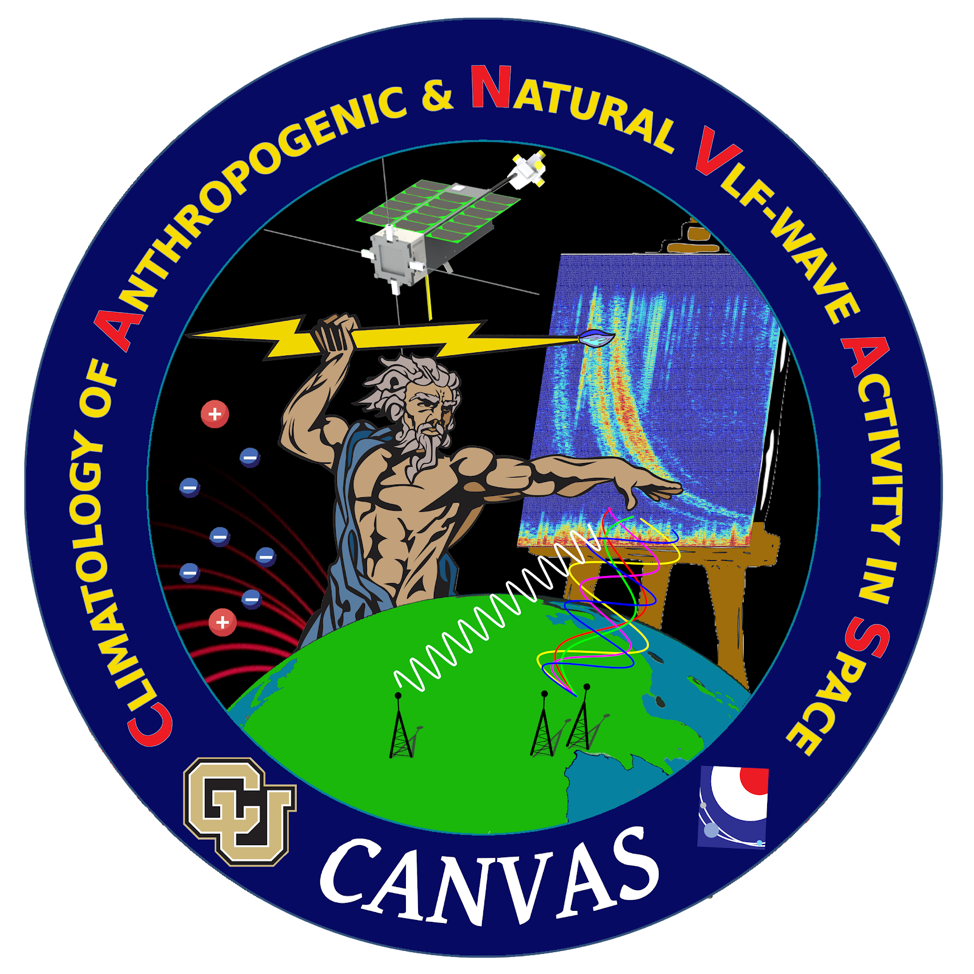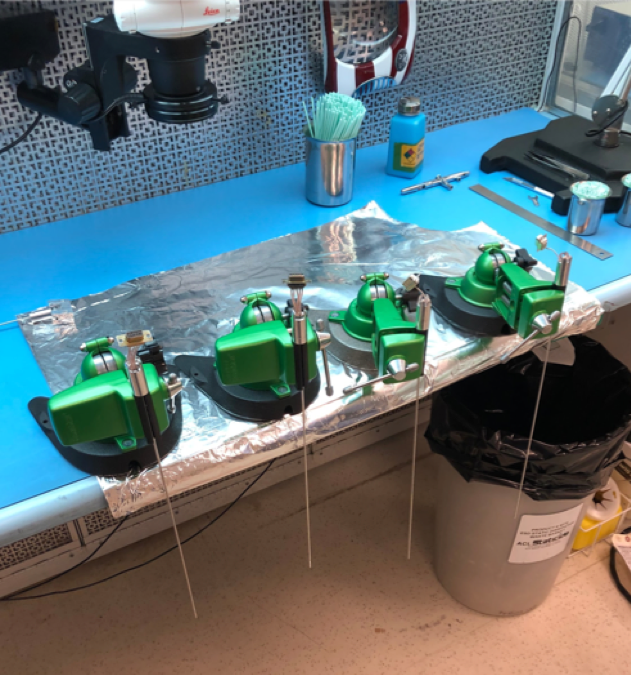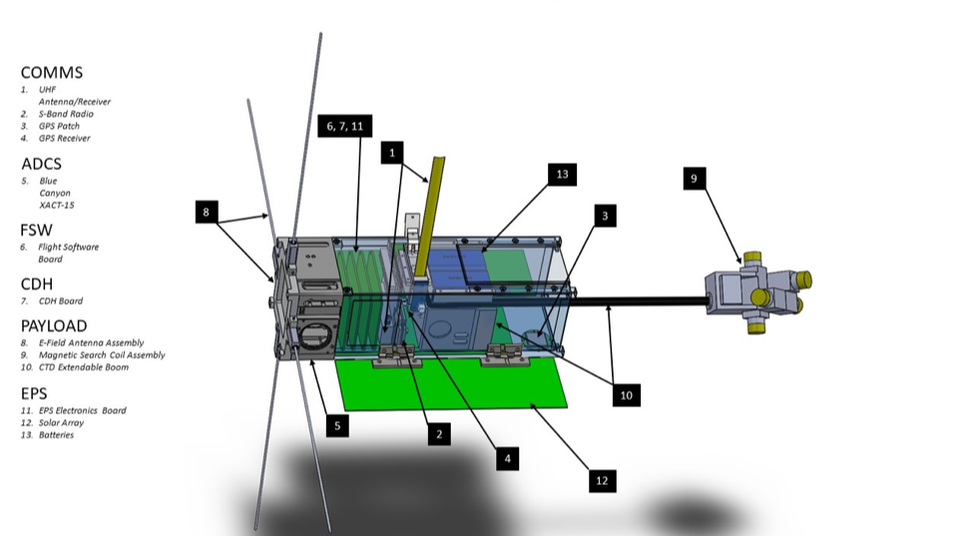Climatology of Anthropogenic and Natural VLF wave Activity in Space (CANVAS)
|
Lightning flashes occur globally 50 times a second! The electromagnetic energy that occurs from a lightning flash (also called an electromagnetic pulse, or EMP) is mostly in the very low frequency (VLF) range and propagates throughout the Earth-ionosphere waveguide. When the lightning EMP enters the magnetosphere, it propagates as a whistler-mode wave, often simply referred to as a “whistler”, named from the short descending tone heard when played back over audio. These whistlers can then interact with radiation belt particles and play a role in radiation belt dynamics, even inducing electron precipitation events [Graf et al., 2009]. In addition to lightning, ground-based transmitters can also radiate VLF energy into the magnetosphere and interact with the radiation belts. VLF wave propagation can also reveal characteristics of the D-region of the ionosphere, the lowest level of the ionosphere.
|
We aim to further understand the propagation of this energy from both lightning and ground-based transmitters in the near-Earth space environment through CANVAS. The Climatology of Anthropogenic and Natural VLF wave Activity in Space (CANVAS) mission was selected in Spring 2019 for funding by NSF to measure VLF waves in low Earth orbit.
In order to obtain a complete set of wave parameters to characterize observed VLF waves, CANVAS will fly both a three-axis search coil antenna (left figure below) and two axis dipole E-field antennas (right figure below). The three magnetic field components from the search coil and two electric field components from the antennas can be used to completely describe a propagating plane wave [Santolík et al., 2003].
In order to obtain a complete set of wave parameters to characterize observed VLF waves, CANVAS will fly both a three-axis search coil antenna (left figure below) and two axis dipole E-field antennas (right figure below). The three magnetic field components from the search coil and two electric field components from the antennas can be used to completely describe a propagating plane wave [Santolík et al., 2003].
The three-axis search coil antenna is being built by CNRS and will have a similar design to VPM. To obtain magnetically clean measurements, the three-axis search coil antenna will be deployed by a 1 meter long carbon fiber boom manufactured by CTD. This instrument and boom will all fit into a space of 1.5U prior to deployment! At CU, we will develop the preamplifier board and instrument circuitry for this search coil.
The two axis dipole antennas are being developed by students at CU, along with the antenna holders and preamplifier. The antennas employ a simple and cost effective design and will undergo environmental testing this year.
Finally, CANVAS will be expanding VPM’s two-channel FPGA processing chain into a five-channel system to process the complete set of wave parameters. These wave parameters, along with timing and positioning information, will comprise CANVAS’s data products and will be collected every second for the duration of the mission - that’s a lot of data for a 3U CubeSat!
The two axis dipole antennas are being developed by students at CU, along with the antenna holders and preamplifier. The antennas employ a simple and cost effective design and will undergo environmental testing this year.
Finally, CANVAS will be expanding VPM’s two-channel FPGA processing chain into a five-channel system to process the complete set of wave parameters. These wave parameters, along with timing and positioning information, will comprise CANVAS’s data products and will be collected every second for the duration of the mission - that’s a lot of data for a 3U CubeSat!
Our Work
|
CANVAS is a 3U CubeSat. That means both instruments, radios, onboard computer and data storage, attitude determination and control system, and power system has to fit in a space that is 30cm by 10cm! Currently, a team of 10 graduate students is working to select components and increase the fidelity of the CANVAS design to optimize space and mass. Graduate students are working on all aspects of CANVAS including instrument circuitry, structural and thermal analysis, command and data handling, and interfacing Blue Canyon Technologies XACT attitude determination and control system. The CANVAS team aims to complete PDR early December 2019 and begin tackling the CDR phase in Spring 2020. In the next stage, we’ll continue to increase the technology readiness of the E-field antennas, develop flight software, and further improve the fidelity of our design - and we’re always looking for interested students to join us!
|
References
- Abel, B., and R. M. Thorne (1998), Electron scattering loss in earth’s inner magnetosphere: 1. dominant physical processes, Journal of Geophysical Research: Space Physics, 103(A2), 2385–2396.
- Graf, K., U. S. Inan, D. Piddyachiy, P. Kulkarni, M. Parrot, and J. Sauvaud (2009), Demeter observations of transmitter-induced precipitation of inner radiation belt electrons, Journal of Geophysical Research: Space Physics, 114(A7).
- Graf, K. L., N. G. Lehtinen, M. Spasojevic, M. B. Cohen, R. A. Marshall, and U. S. Inan (2013a), Analysis of experimentally-validated trans-ionospheric attenuation estimates of vlf signals, J. Geophys. Res.
- Inan, U. S., and D. L. Carpenter (1987), Lightning-induced electron precipitation events observed at L=2.4 as phase and amplitude perturbations on subionospheric VLF signals, J. Geophys. Res., 92(A4), 3293–3303.
- Santolík, O., M. Parrot, and F. Lefeuvre (2003), Singular value decomposition methods for wave propagation analysis, Radio Science, 38(1).





